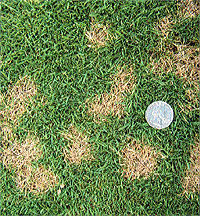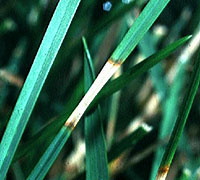Seasonal Fungi FAQ

Red Thread & Other Seasonal Fungi - Seasonal fungi are picked up easily in lawns throughout Southern New England in late May and June. It is important to know that there is nothing "wrong" with your lawn. It is part of Mother Nature's process and the bio-processes are driven by climate change. The daytime temperatures are on the rise and the nighttime temps are still relatively cool. Combine those factors with consistently high humidity and we have conditions that favor the spread of fungi in turf. We understand that fungi are a nuisance and are unsightly. Below are the options to consider that we have found to work well.
Fungicide Controls - We prefer applying granular fungicide 2-3 times at a 2-3 week interval for both preventative and curative methods. Granular fungicides range in price from $75-$150 for our average lawn size. Thus, these methods, however effective, can be expensive.
Cultural Controls - There are practices we can employ to help reduce the spread of the fungi. We recommend the following.
- Mowing Practices - Be sure to wipe blades before and after each mow to help reduce spread of fungi. Let the grass grow a little taller than normal. Then mow the lawn down to approximately 3 inches. Make sure to bag the clippings. This will bring a lot of the diseased matter OUT of the lawn. If you cannot bag, rake the clippings out. Do this for several weeks until the weather changes to more arid, less humid. Then regular mowing practices are preferred.
- Watering Practices - Keeping the lawn irrigated is important. We suggest that the lawn be watered for 30-40 minutes per zone only 2x weekly while fungi prevail. The days in between watering allow the turf to dry out and ventilate. The grass needs to continue growing while fungi are active in the lawn. If the lawn is not watered during the period, the diseased areas are more susceptible to summer drought damage.
 What causes the fungi... The fungi are introduced by spores that lie dormant until the right levels of heat and humidity are achieved. While actively growing, the fungi produce millions of more spores that will lie dormant over the following winter to become active in the lawn again the following spring. Thus, lawns that have fungi will tend to have them in following seasons as the climate tends to be consistent.
Having the lawn aerated and/or dethatched at the proper times will help increase ventilation in the lawn and help reduce the likelihood of fungi.
What causes the fungi... The fungi are introduced by spores that lie dormant until the right levels of heat and humidity are achieved. While actively growing, the fungi produce millions of more spores that will lie dormant over the following winter to become active in the lawn again the following spring. Thus, lawns that have fungi will tend to have them in following seasons as the climate tends to be consistent.
Having the lawn aerated and/or dethatched at the proper times will help increase ventilation in the lawn and help reduce the likelihood of fungi.
An easy fix... Lawns that have been diseased with seasonal fungi are likely to need some minor repair. The fall is the best time for such repairs. In almost all cases, a basic aeration & overseeding of the lawn is all that is required.





